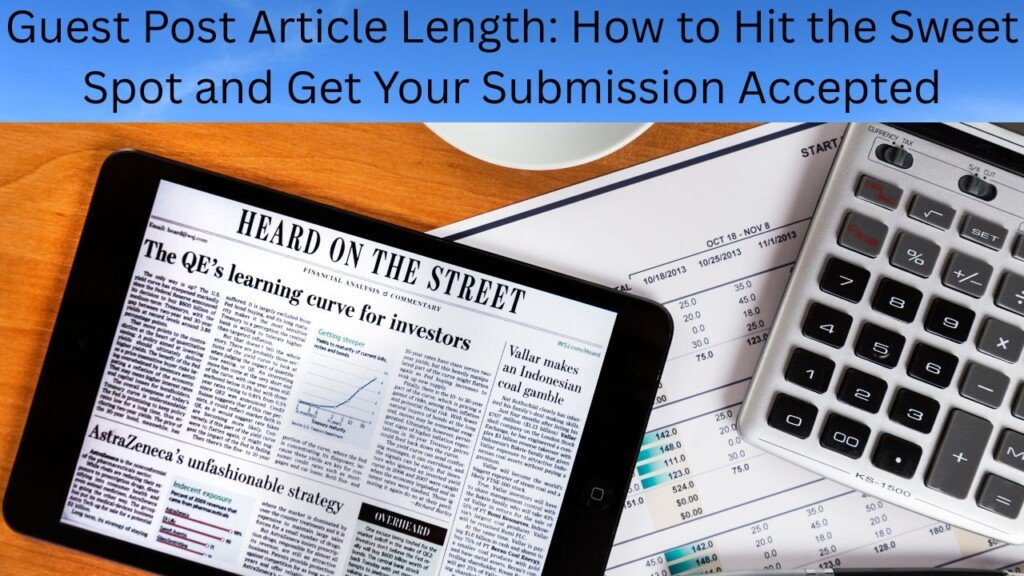Guest Post Article Length: How to Hit the Sweet Spot and Get Your Submission Accepted
You’ve put hours into writing what you think is a killer guest post. Then, the nagging question hits: Is my article too long? Too short? The fear of rejection over length is real, especially when guidelines are vague or unclear. But the secret is this: it’s not about hitting a specific word count—it’s about crafting a strategic, valuable article that fits the publisher’s expectations and needs. This guide will show you exactly how to do that.

Quick Overview: What’s the Ideal Guest Post Length?
Most publishers want guest posts between 800 and 1,500 words. This range hits the sweet spot for many blogs, balancing detail with readability.
But remember, this is just a starting point. Your article’s perfect length depends on:
- The complexity of your topic
- The publisher’s style and audience
- The format and goal of your content
Ready to dive deeper? Let’s break down exactly how to find the right length and write an article editors love.
Step 1: Research the Publisher’s Content and Guidelines
Before you start writing, do some homework:
- Check Submission Guidelines: Look for any explicit word count rules or style guides. If none exist, don’t worry.
- Analyze Recent Guest Posts: Use a free online word counter (like SEO Media World’s tool) to check the length of 3-5 recent guest articles. This reveals the publisher’s implicit expectations.
- Review Evergreen Articles: See which posts perform well over time. These likely reflect the publisher’s preferred style and depth.
Following these steps helps you tailor your article perfectly and avoids blind guessing.
The 3 Key Factors That Determine Your Guest Post Length
1. Topic Complexity
- Simple topics or quick tips can be covered in 800-1,000 words.
- Technical or in-depth subjects often require 1,200-1,500+ words to fully explain and provide value.
2. Content Format
- Listicles or “how-to” guides usually stay under 1,200 words.
- Case studies, interviews, or research-heavy pieces naturally demand more space, sometimes 1,500 to 2,000 words.
3. Publisher Style & Audience
- Some blogs prefer concise, punchy content for quick consumption.
- Others favor long-form, evergreen content that ranks well on Google and builds authority.
Matching your post to the publisher’s tone improves your chances of acceptance.
The Power of Headlines and Subheadings
A well-crafted headline does more than grab attention. It sets expectations and convinces editors your post is worth their readers’ time—even if it’s longer.
Strategic subheadings break the article into digestible parts. They help:
- Make the content easy to scan
- Signal clear sections for different points
- Give a sense of organized flow, making a longer article feel less daunting
Editors appreciate content that respects readers’ time and makes navigation simple.
Visuals and Readability: Formatting Matters
A 1,500-word article can feel like a breeze if it’s formatted well. Consider these tips:
- Use short paragraphs (1-3 sentences).
- Add bullet points or numbered lists for key info.
- Bold important terms or phrases to guide the reader’s eye.
- Include relevant images, charts, or screenshots to break up text and illustrate points.
- Keep it mobile-friendly, since many readers view content on phones.
Editors are more likely to accept longer articles if the formatting improves readability and engagement.
Pro Tip: How to Analyze Competitors’ Guest Post Length
Want an edge? Use browser extensions like Word Counter or online tools to quickly check the word counts of guest posts on your target site.
Here’s how:
- Pick 3-5 guest posts published recently.
- Use the tool to get exact word counts.
- Note any patterns in length or structure.
This data-driven approach lets you pitch articles that fit perfectly with what editors want.
Make Them Count
Your intro should promise a clear benefit to readers and hook their interest. A strong opening signals to editors that your article delivers value, justifying length.
Your conclusion should wrap up the topic with a clear takeaway or call to action. It reinforces your article’s purpose and leaves a lasting impression.
Great intros and conclusions make an article feel complete and well thought-out, which editors love.
Common Mistakes to Avoid When Deciding Guest Post Length
- Adding fluff just to hit word count: Editors can tell when content is padded with unnecessary info.
- Cutting key details to be “concise”: Don’t sacrifice clarity or depth to shorten your post.
- Ignoring publisher preferences: Submit content that fits their typical length and style, or risk rejection.
Keep your content focused, valuable, and aligned with your research.
Final Checklist Before Submission
Before hitting send, ask yourself:
- Does my article provide enough detail to be a definitive guide?
- Is the formatting clean and easy to read?
- Have I edited out all filler to keep it concise?
- Does my conclusion leave readers with a clear takeaway?
- Have I matched the article length to what the publisher expects?
A quick review boosts your chances of acceptance.
Conclusion: Think Like an Editor, Write Like a Pro
Don’t just aim to avoid rejection—write an article editors can’t wait to publish. Focus on solving their problems by delivering valuable content that fits their style and audience.
Remember, the perfect guest post length is a strategy, not a number. Do your research, write with purpose, format for readability, and tailor your message to the publisher.
With this approach, your guest post won’t just meet length requirements—it will stand out as a valuable asset that saves editors time and effort.